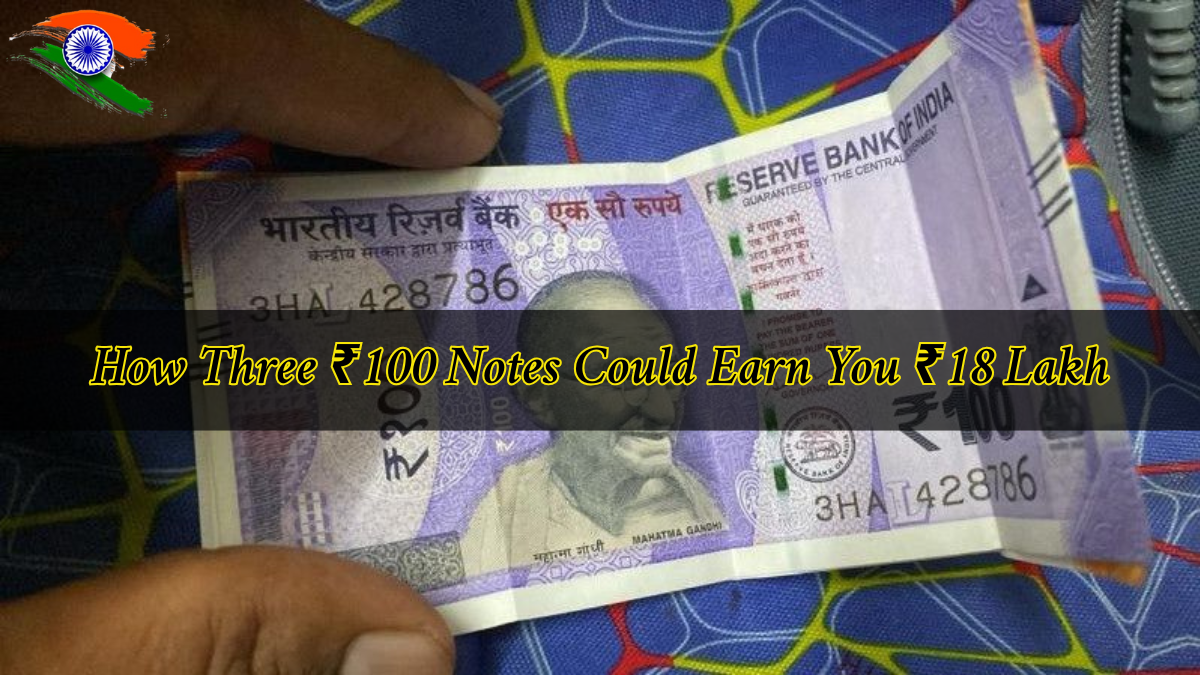Are you one of those people who enjoy collecting old currency or occasionally stumble upon a unique note tucked away in a wallet or piggy bank? What if we told you that a single ₹100 note in your possession could potentially make you ₹6 lakh or more? And having three such notes could fetch you as much as ₹18 lakh?

Welcome to the fascinating world of rare currency trading, where collectors are willing to pay huge sums for unique serial numbers and rare features. In this article, we’ll guide you through the features that make a ₹100 note extremely valuable, how you can verify its rarity, and where to sell it safely online.
Quick Summary: High-Value ₹100 Note Explained
| Criteria | Details |
|---|---|
| Currency Type | ₹100 Indian currency note |
| Potential Value | ₹6 lakh per note (up to ₹18 lakh for three) |
| Key Feature for High Value | Serial number ‘786’, Mahatma Gandhi portrait, or Ashoka Pillar image |
| Reason for Demand | Cultural significance, rarity, collector interest |
| Selling Platform | www.olx.in |
| Process to Sell | Upload note image and details on OLX |
| Verification Required? | Self-check of serial number and note condition |
Why Are Some ₹100 Notes Worth Lakhs?
While most ₹100 notes are just a standard part of your wallet, a select few have special features that attract rare currency collectors, investors, and even cultural buyers. These buyers are willing to pay lakhs of rupees for a single piece if it meets certain criteria.
This valuation doesn’t come from the RBI or any official authority but from the private collectors’ market, where value is determined by rarity, demand, and sentiment.
Rare ₹100 Note Features That Can Make You Lakhs
1. Serial Number ‘786’
- This number is highly auspicious, especially in Islamic culture.
- It’s often associated with blessings, prosperity, and divine symbolism.
- A ₹100 note with ‘786’ as the last three digits of the serial number is in very high demand.
2. Mahatma Gandhi Portrait Series
- Notes featuring Mahatma Gandhi are common, but older versions from the 1990s or early 2000s have collector value.
- The crisper the note, the higher the value — especially if combined with a rare serial number.
3. Ashoka Pillar Note
- Even rarer are the pre-Gandhi notes that featured the Ashoka Pillar.
- These are often no longer in circulation but can still be found in collections or piggy banks.
- Their age and historical value increase demand among collectors.
4. Uncirculated or Mint Condition
- A note in crisp, uncirculated condition will fetch a significantly higher price.
- Folds, tears, or stains reduce value, so proper storage is crucial.
Cultural & Emotional Significance of ‘786’
- In Islamic tradition, the number 786 is believed to represent “Bismillah al-Rahman al-Rahim” (In the name of Allah, the Most Gracious, the Most Merciful).
- Many people believe it brings good fortune and maintains peace and prosperity at home.
- Because of this belief, people are often willing to pay a premium to own notes or items bearing this number.
How to Sell Your Rare ₹100 Note Online
1. Visit a Trusted Platform: OLX
The best and most common platform to sell rare Indian currency is OLX. Here’s how you can use it:
Steps to Sell Your Note:
- Go to www.olx.in
- Create a free account using your mobile number or email ID
- Click on “Post an Ad”
- Choose category “Hobbies, Collectibles” and subcategory “Coins & Notes”
- Upload clear images of your ₹100 note (front and back)
- Add a compelling title and description, including serial number, year, and condition
- Set your desired price (e.g., ₹6 lakh)
- Post the ad and wait for interested buyers to contact you
2. Alternative Platforms to Explore
- eBay India
- Quikr
- Numismatic societies and auctions
Make sure to verify the authenticity of the buyer and use secure payment methods.
Tips to Maximize Your Sale
- Clean but don’t damage: Use a soft cloth to gently clean dust without folding the note.
- High-quality photos: Use daylight to click clear, high-resolution images.
- Detailed description: Include the serial number, year of issue, any visible errors or variations, and condition.
- Negotiation: Be ready to negotiate; many buyers start low but may settle near your asking price.
- Authentication: Join online collector forums or groups for help authenticating your note if needed.
Things to Be Cautious About
- Avoid sharing personal banking information with unknown buyers.
- Always use secure communication and meet in public places if opting for in-person deals.
- Beware of fraudulent buyers asking for advance money or offering unrealistic prices.
Frequently Asked Questions (FAQs)
Q1. Can all ₹100 notes fetch lakhs?
Answer: No. Only notes with special features like serial number ‘786’, mint condition, or unique historical elements are valuable to collectors.
Q2. Is it legal to sell old Indian currency online?
Answer: Yes, as long as the currency is not demonetized or defaced, and the sale is made to collectors for numismatic purposes.
Q3. What other serial numbers are considered rare?
Answer: Palindromes (e.g., 1234321), repeating digits (e.g., 111111), or low serials (e.g., 000001) are often in demand.
Q4. Can I sell my note on platforms like Amazon or Flipkart?
Answer: No. These platforms do not allow the sale of currency notes due to regulatory restrictions.
Q5. How can I verify the year of the note?
Answer: The year of printing is generally printed on the reverse (back side) of the note at the bottom.
Q6. Is there any registration required with the RBI for selling old notes?
Answer: No. There is no need for RBI registration if the sale is for collection purposes and not misuse.
Conclusion
With the rise of numismatic interest and digital selling platforms, selling rare ₹100 notes is not just a hobby but a potential source of substantial income. If your note matches the special features discussed above — especially the 786 serial number — you may have a financial windfall waiting in your drawer.
So, what are you waiting for? Check your wallet, look inside that old piggy bank, and explore the untapped treasure you might already own.
For More Information Click Here
